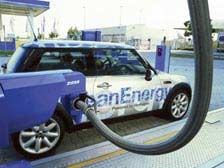Moshe Stern, head of C.En (Clean Energy) says his company's scientists have developed a revolutionary breakthrough that will enable automobile manufacturers to produce - and sell - cars that use hydrogen power.
While producing the hydrogen is easy enough, getting the fuel into the car and storing it in a fuel tank is one of the biggest obstacles for the technology. This, industry experts say, has traditionally been the deal-breaker for increased hydrogen use. Most hydrogen vehicles on the road use a liquid form of the material, which requires a super strong and super heavy storage tank. Liquid hydrogen is unstable and needs to be insulated from the excess shocks from bumps and potholes that are a part of everyday driving, so the tanks themselves are large and heavy, and hold at most 20 liters of fuel - enough for barely 150 miles of driving.
Then there's the issue of integrating the fuel into internal combustion vehicles which, for better or worse, are unlikely to be phased out anytime soon - as well as the question of where drivers are supposed to fill up, since hydrogen stations are rather rare, at least in my driving experience.
All these are legitimate concerns that have kept hydrogen development restricted more or less to the lab, Stern says - and all concerns that are addressed, and solved, with C.En's hydrogen storage and supply solution. The difference? C.En's tank uses hydrogen gas, collected from the environment (i.e. not produced from fossil fuels) and enclosed in a thin but leakproof glass container. The best part: You'll be able to buy your "gas" at automotive or discount stores, fueling up every 370 miles or so.
"We can build a 60-liter tank that can travel up to 370 miles. and weighs no more than 50 kg.," Stern said, unlike tanks currently used for liquid hydrogen that weigh hundreds of kilos.
"Our company's breakthrough is in accumulating hydrogen in a glass material that is very small, only a few microns," said Stern, who is also president of waste treatment company Environmental Energy Resources (EER). "You don't need to transport hydrogen to fuel stations and you don't need pipelines. The tanks will be like a battery that can be replaced and you can carry a reserve in the car."
The cells, in fact, will act just like batteries in electric or hybrid cars and fit right in with the standard internal combustion engine - which means that Detroit or Yokohama don't have to retool their factories or production lines to build cars with the capacity for hydrogen cells. The knowhow and means of production are in use right now, in fact, as nearly every car manufacturer is already producing hybrids or straight electric cars.

